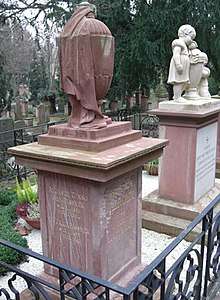Carl Gassner
Carl Gassner is a German physician (17 November 1855 in Mainz; † 31 January 1942), scientist and inventor, better known to have contributed to improve the Leclanché cell and to have fostered the development of the first dry cell, also known as the zinc–carbon battery, less likely to break or leak and that could be effectively industrially produced at large scale.[1]
Carl Gassner | |
|---|---|
| Born | 17 November 1855 Mainz (Germany) |
| Died | 31 January 1942 |
| Nationality | German |
| Occupation | Physician |

Life
Gassner studied the medicine at the University of Strasbourg and then practiced in Mainz (Germany) as a specialist in diseases of the eyes and ears. He also conducted experiments in physics and chemistry at the Balbach watchmaking industry.
Invention of dry cell
In 1880, most of the door bells operated with a wet Leclanché cell containing an aqueous electrolyte solution which often dried out, rendering the cell unusable. To remediate to this inconvenient, in 1876, Georges Leclanché started to jellify the electrolyte of his cell by adding starch to the ammonium chloride, making also his cell more portable.[2]
In 1885, Gassner also decided to modify the Leclanché cell by immobilising the liquid electrolyte in plaster of Paris used as a porous binder, to which he added hydrophilic chemicals and zinc chloride. The purpose of the addition of ZnCl2 was to limit the corrosion rate of the zinc anode when the cell is not used and so to extend the service life of the cell. On 8 April 1886 he obtained a patent in Germany, and on 15 November 1887 in the United States.[3] He also obtained different patents in Austria-Hungary, Belgium, France and England. His dry cell became known in 1890, when a friend of his shopkeeper asked him for help because the door bell did not work. Later also the other dealers wanted his dry cell.
Subsequently, the director of the Erfurt post-office ordered 100,000 batteries, forcing Gassner to establish a factory in Frankfurt. He could have earned millions of marks, but for peace he renounced all the rights of the Frankfurt company and the production was <f name="undefined" /> interrupted. He is buried in the main cemetery of Mainz.
Zinc-carbon battery
The global chemical reaction occurring in the zinc-carbon battery is the following:
See also
- History of the battery
- Georges Leclanché
- Leclanché cell
- Zinc-carbon battery
References
- "Biography of Carl Gassner". The Hebrew University of Jerusalem. Archived from the original on 10 February 2008.
- Bernard Pire, "Leclanché Georges (1839–1882)", Encyclopædia Universalis [on line], view in the French language on 1 January 2018. URL: http://www.universalis.fr/encyclopedie/georges-leclanche/
- "Patent No. 373064 of the US-Patent Office". Retrieved 1 January 2018.
External links
- "Carl Gassner on battery facts". Archived from the original on 10 November 2011. Retrieved 10 October 2011.
- C. Cleveland. "Gassner, Carl on Encyclopedia of Earth". Retrieved 10 October 2011.
- "Leclanche cell (English)".
- "American Chemical Society National Historic Chemical Landmarks. Columbia Dry Cell Battery". Retrieved 3 January 2018.
- "Battery history". Retrieved 3 January 2018.
- "Carl Gassner – inventor of dry cell battery". Retrieved 3 January 2018.